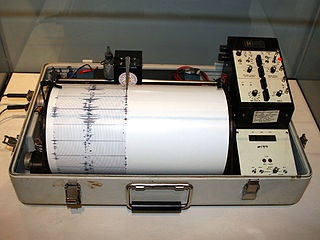|
|
| |
|
|
| |
|
|
|
|
| |
 |
| Kinemetrics
seismograph. |
Seismometers
A seismometer is an instrument that responds to ground
motions, such as caused by earthquakes, volcanic
eruptions, and explosions. Seismometers are usually
combined with a timing device and a recording device to
form a seismograph. The output of such a device—formerly
recorded on paper (see picture) or film, now recorded
and processed digitally—is a seismogram. Such data is
used to locate and characterize earthquakes, and to
study the Earth's internal structure.
A simple seismometer, sensitive to up-down motions of
the Earth, is like a weight hanging from a spring, both
suspended from a frame that moves along with any motion
detected. The relative motion between the weight (called
the mass) and the frame provides a measurement of the
vertical ground motion. A rotating drum is attached to
the frame and a pen is attached to the weight, thus
recording any ground motion in a seismogram.
Any movement of the ground moves the frame. The mass
tends not to move because of its inertia, and by
measuring the movement between the frame and the mass,
the motion of the ground can be determined. |
|
Nomenclature
The word derives from the Greek σεισμός, seismós, a
shaking or quake, from the verb σείω, seíō, to shake;
and μέτρον, métron, to measure, and was coined by David
Milne-Home in 1841, to describe an instrument designed
by Scottish physicist James David Forbes.
Seismograph is another Greek term from seismós and
γράφω, gráphō, to draw. It is often used to mean
seismometer, though it is more applicable to the older
instruments in which the measuring and recording of
ground motion were combined, than to modern systems, in
which these functions are separated. Both types provide
a continuous record of ground motion; this record
distinguishes them from seismoscopes, which merely
indicate that motion has occurred, perhaps with some
simple measure of how large it was.
The technical discipline concerning such devices is
called seismometry, a branch of seismology.
The concept of measuring the "shaking" of something
means that the word "seismograph" might be used in a
more general sense. For example, a monitoring station
that tracks changes in electromagnetic noise affecting
amateur radio waves presents an rf seismograph. And
Helioseismology studies the "quakes" on the Sun. |
|
History
The first seismometer was made in China during the 2nd
century. The first Western description of the device
comes from the French physicist and priest Jean de
Hautefeuille in 1703. The modern seismometer was
developed in the 19th century.
In December 2018, a seismometer was deployed on the
planet Mars by the InSight lander, the first time a
seismometer was placed onto the surface of another
planet.
Ancient era
In AD 132, Zhang Heng of China's Han dynasty invented
the first seismoscope (by the definition above), which
was called Houfeng Didong Yi (translated as, "instrument
for measuring the seasonal winds and the movements of
the Earth"). The description we have, from the History
of the Later Han Dynasty, says that it was a large
bronze vessel, about 2 meters in diameter; at eight
points around the top were dragon's heads holding bronze
balls. When there was an earthquake, one of the dragons'
mouths would open and drop its ball into a bronze toad
at the base, making a sound and supposedly showing the
direction of the earthquake. On at least one occasion,
probably at the time of a large earthquake in Gansu in
AD 143, the seismoscope indicated an earthquake even
though one was not felt. The available text says that
inside the vessel was a central column that could move
along eight tracks; this is thought to refer to a
pendulum, though it is not known exactly how this was
linked to a mechanism that would open only one dragon's
mouth. The first earthquake recorded by this seismoscope
was supposedly "somewhere in the east". Days later, a
rider from the east reported this earthquake. |
|
|
|
|
|
|
|
|
|
|
|
|
|
|
|
|
|
|
Search Fun Easy English |
|
|
|
|
|
|
|
|
|
|
|
|
|
|
|
About
Contact
Copyright
Resources
Site Map |